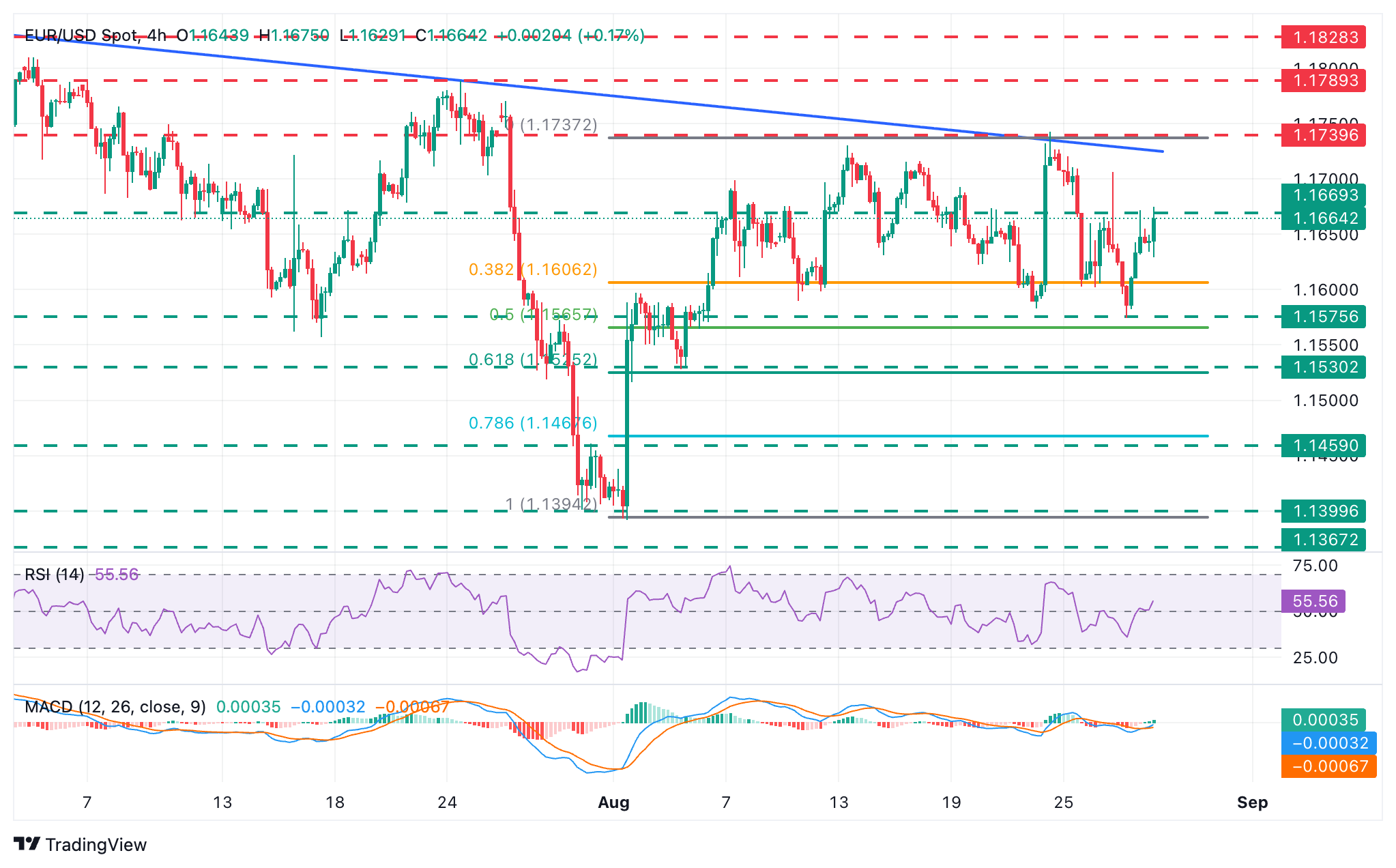Created
: 2025.08.28














![]() 2025.08.28 20:41
2025.08.28 20:41
The EUR/USD pair extends its recovery from 1.1575 trading, reaching intra-day highs at 1.1670 ahead of the US session opening, with all eyes on the US GDP and Jobless Claims releases due later on the day. On Wednesday, dovish comments from New York Federal Reserve (Fed) President John Williams left the door open for an interest rate cut in September and increased pressure on the USD.
Williams affirmed in an interview on CNBC that interest rates are likely to move lower over time, and that, in his opinion, every monetary policy meeting is "live". These comments fuelled investors' expectations that a cut in September is a plausible option, which undermined support for the USD.
The US Dollar was also weighed down by US President Donald Trump's attacks on the Fed. Earlier this week, Trump attempted to fire the central bank's Governor Lisa Cook, with the likely aim of replacing her with a dovish-leaning policymaker. This is the latest episode of an extended series of attacks that have raised doubts about its status as an independent central bank.
Market hopes of Fed easing have offset the negative impact of the French political crisis. French opposition parties have refused to support Prime Minister Françoise Bayrou in a confidence vote announced for September, which will force the government to resign and lead to another snap election.
Eurozone data released earlier on Thursday has failed to support the Euro. The Economic Sentiment index deteriorated to 95.2 from a downwardly revised 95.7 reading in June, below the market expectations of a 96.0 reading. Industrial Confidence dropped to -1.3 from -10.5, also revised down from the previously reported 10.4 reading, while Consumer Confidence remains at -15.5, unchanged from the previous month.
In the US, the second estimate of the Q2 Gross Domestic Product (GDP) is expected to be revised slightly upwards. The impact of these figures on FX markets is likely to be limited, with investors bracing for the US Personal Consumption Expenditures (PCE) Price Index release due on Friday, for more clues about the outcome of September's Federal Open Market Committee (FOMC) meeting.
The table below shows the percentage change of Euro (EUR) against listed major currencies today. Euro was the strongest against the US Dollar.
| USD | EUR | GBP | JPY | CAD | AUD | NZD | CHF | |
|---|---|---|---|---|---|---|---|---|
| USD | -0.25% | -0.17% | -0.41% | -0.17% | -0.37% | -0.25% | -0.37% | |
| EUR | 0.25% | 0.12% | -0.19% | 0.07% | -0.09% | 0.01% | -0.10% | |
| GBP | 0.17% | -0.12% | -0.28% | -0.01% | -0.21% | -0.09% | -0.20% | |
| JPY | 0.41% | 0.19% | 0.28% | 0.26% | 0.00% | -0.12% | 0.08% | |
| CAD | 0.17% | -0.07% | 0.01% | -0.26% | -0.20% | -0.08% | -0.10% | |
| AUD | 0.37% | 0.09% | 0.21% | -0.00% | 0.20% | 0.12% | 0.00% | |
| NZD | 0.25% | -0.01% | 0.09% | 0.12% | 0.08% | -0.12% | -0.10% | |
| CHF | 0.37% | 0.10% | 0.20% | -0.08% | 0.10% | -0.01% | 0.10% |
The heat map shows percentage changes of major currencies against each other. The base currency is picked from the left column, while the quote currency is picked from the top row. For example, if you pick the Euro from the left column and move along the horizontal line to the US Dollar, the percentage change displayed in the box will represent EUR (base)/USD (quote).

EUR/USD bears failed to confirm below the bottom of the last three weeks' trading range, at 1.1585, but the pair's immediate bias remains moderately bearish. The Relative Strength Index (RSI) is flat around the 50 level, but a sequence of lower highs and lower lows after the rejection above 1.1700 last week suggests that further depreciation is likely.
Wednesday's high at 1.1670 is holding bulls for now and keeps the immediate bearish structure in play. Above here, the confluence of the trendline resistance from July 1 highs, now at 1.1730, and the August 22 high, at 1.1740, is likely to pose a significant challenge for bulls.
To the downside, the area between 1.1575 and 1.1590, which broadly encloses the lows of August 11, 22, and 27, is the key level for bears. Below here, 1.1562, the 50% Fibonacci retracement level of the early August bullish run might provide some support ahead of the August 5 low, near 1.1530.
The real Gross Domestic Product (GDP) Annualized, released quarterly by the US Bureau of Economic Analysis, measures the value of the final goods and services produced in the United States in a given period of time. Changes in GDP are the most popular indicator of the nation's overall economic health. The data is expressed at an annualized rate, which means that the rate has been adjusted to reflect the amount GDP would have changed over a year's time, had it continued to grow at that specific rate. Generally speaking, a high reading is seen as bullish for the US Dollar (USD), while a low reading is seen as bearish.
Read more.Last release: Wed Jul 30, 2025 12:30 (Prel)
Frequency: Quarterly
Actual: 3%
Consensus: 2.4%
Previous: -0.5%
Source: US Bureau of Economic Analysis
The US Bureau of Economic Analysis (BEA) releases the Gross Domestic Product (GDP) growth on an annualized basis for each quarter. After publishing the first estimate, the BEA revises the data two more times, with the third release representing the final reading. Usually, the first estimate is the main market mover and a positive surprise is seen as a USD-positive development while a disappointing print is likely to weigh on the greenback. Market participants usually dismiss the second and third releases as they are generally not significant enough to meaningfully alter the growth picture.
The Initial Jobless Claims released by the US Department of Labor is a measure of the number of people filing first-time claims for state unemployment insurance. A larger-than-expected number indicates weakness in the US labor market, reflects negatively on the US economy, and is negative for the US Dollar (USD). On the other hand, a decreasing number should be taken as bullish for the USD.
Read more.Last release: Thu Aug 21, 2025 12:30
Frequency: Weekly
Actual: 235K
Consensus: 225K
Previous: 224K
Source: US Department of Labor
Every Thursday, the US Department of Labor publishes the number of previous week's initial claims for unemployment benefits in the US. Since this reading could be highly volatile, investors may pay closer attention to the four-week average. A downtrend is seen as a sign of an improving labour market and could have a positive impact on the USD's performance against its rivals and vice versa.
against
![]()
Created
: 2025.08.28
![]()
Last updated
: 2025.08.28

FXStreet is a forex information website, delivering market analysis and news articles 24/7.
It features a number of articles contributed by well-known analysts, in addition to the ones by its editorial team.
Founded in 2000 by Francesc Riverola, a Spanish economist, it has grown to become a world-renowned information website.
We hope you find this article useful. Any comments or suggestions will be greatly appreciated.
We are also looking for writers with extensive experience in forex and crypto to join us.
please contact us at [email protected].
Disclaimer:
All information and content provided on this website is provided for informational purposes only and is not intended to solicit any investment. Although all efforts are made in order to ensure that the information is correct, no guarantee is provided for the accuracy of any content on this website. Any decision made shall be the responsibility of the investor and Myforex does not take any responsibility whatsoever regarding the use of any information provided herein.
The content provided on this website belongs to Myforex and, where stated, the relevant licensors. All rights are reserved by Myforex and the relevant licensors, and no content of this website, whether in full or in part, shall be copied or displayed elsewhere without the explicit written permission of the relevant copyright holder. If you wish to use any part of the content provided on this website, please ensure that you contact Myforex.
Myforex uses cookies to improve the convenience and functionality of this website. This website may include cookies not only by us but also by third parties (advertisers, log analysts, etc.) for the purpose of tracking the activities of users. Cookie policy